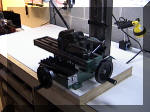
So I investigated the mini-mill, and it only weighed 125 pounds. This was much more manageable. I was lucky enough to have a very obliging driver, who had a lift gate, and shortly afterwards, the mill was sitting on the shop floor. It was held in place with two bolts, one of which had vanished. The other was loose. Fortunately, the mill was not damaged. With the aid of a friend, I got it up on the workbench, having modified the workbench to hold it well. I raised the mill off the workbench surface to allow better access to the handle. Since I then placed the thing so the handle stuck out anyway, I really didnít manage to achieve too much. Still, it looks pretty. Now the next thing I did was to mess up the gearing by trying to lubricate the drive gear to the headstock. I did not put the driven gear from the motor back on full, which allowed the shaft to slide down. That caused the gears to drag on the shift fork. The clue was when the mill (somewhat noisy) began to smoke. Fortunately, the gear was only a little damaged, and the replacement gear arrived in a week. Sigh.
However, I really know how to take that thing apart. Now the next thing I did do was to take most of the mill apart and clean it. It had cast iron dust here and there, not a pretty sight. Iíve not decided what to change first, but it did need a lamp. Thereís two possibilities, one is the halogen lamp thatís on the little magnetic base behind the mill. It doesnít work all that well. The second one is a gooseneck lamp that was made for a DeWalt scroll saw. Drill out one hole and it mounts very well on the back mounting bolt. Itís very handy.
In the background is a television for in-flight entertainment and a drill sharpener. Very useful thing, that drill sharpener, especially since the cheap drills need resharpening every now and then.

The mill needed the usual set of adjustments, so I suppose I shouldnít have been surprised.
I have in mind the following modifications:
A dial indicator for depth.
Possibly an RPM readout. Iím not as certain where it would go, but it does have possibilities. The main problem would be the pickoff. It would be a copy of the one I intend to make for the lathe.
Accessories:
So far, Iíve bought:
2 and 4 flute mills, sizes to 1/2 inch.
Dovetail mill, 1/2 inch
Woodruff cutter, 1/2 inch
One spray can of blue dye.
One small t-square with metric and inch marking.
One set of precision parallels.
One (yet to be delivered) angle shop vise.
One set of hold down clamps, 3/16 inch size.
Probably more to comeÖ.
Definitely more came: Boring head, precision squares, Dovetail mills, 60 degrees, machinist's vise, six inch rotary table, endmill holders, 5C collet fixture, 5C spin indexer. I"m sure that there's something else, but then, I'll try to add it later.